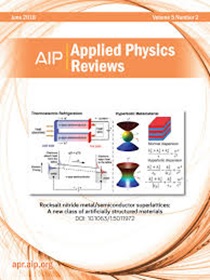Status of Ga2O3 for power device and UV photodetector applications
IF 11.6
1区 物理与天体物理
Q1 PHYSICS, APPLIED
引用次数: 0
Abstract
Gallium oxide (Ga2O3) has been the subject of extensive research over the past decade due to its potential in next-generation power electronics and solar-blind ultraviolet (UV) photodetectors. While Ga2O3 exhibits promising material characteristics for applications in harsh environments, its commercial viability remains under debate, particularly when compared to materials such as aluminum nitride (AlN) and diamond, which possess superior intrinsic properties. This perspective addresses the critical challenges that currently impede the widespread commercialization of Ga2O3-based devices. These challenges include a relatively immature technology base, the difficulty in achieving stable p-type conductivity, inherently low thermal conductivity, the presence of crystallographic defects (nano- and micro-voids), and elevated fabrication costs, all of which negatively impact device reliability and scalability. Mitigation strategies, such as heterojunction implementation, the development of thermal management solutions such as wafer bonding, and defect passivation approaches, are also under investigation. The near-term feasibility of commercially viable Ga2O3-based power electronic devices is a central focus of this discussion. The current status is that Ga2O3 development is far advanced relative to either diamond or especially AlN power electronics but is hampered by lack of a broad base of substrate vendors and a compelling vision for device implementations that provide sufficient improvement over SiC power devices. There are strong geographic differences in device focus, with China prioritizing implementation in grid applications while the United States/Europe appear to consider Ga2O3 devices more for defense and aerospace applications.Ga2O3在功率器件和紫外光电探测器中的应用现状
在过去的十年中,氧化镓(Ga2O3)由于其在下一代电力电子和太阳盲紫外(UV)光电探测器中的潜力而成为广泛研究的主题。虽然Ga2O3在恶劣环境中表现出很好的材料特性,但其商业可行性仍存在争议,特别是与具有优越内在性能的氮化铝(AlN)和金刚石等材料相比。这一观点解决了目前阻碍基于ga2o3的器件广泛商业化的关键挑战。这些挑战包括相对不成熟的技术基础、难以实现稳定的p型电导率、固有的低导热性、晶体缺陷(纳米和微孔)的存在以及制造成本的提高,所有这些都对器件的可靠性和可扩展性产生了负面影响。缓解策略,如异质结的实施,开发热管理解决方案,如晶圆键合,以及缺陷钝化方法,也在研究中。商业上可行的基于ga2o3的电力电子器件的近期可行性是本次讨论的中心焦点。目前的现状是,Ga2O3的发展相对于金刚石或特别是AlN功率电子器件来说要先进得多,但由于缺乏广泛的衬底供应商和对器件实现的令人信服的愿景,无法提供比SiC功率器件足够的改进,因此受到阻碍。在器件重点方面存在很大的地理差异,中国优先考虑在网格应用中实施,而美国/欧洲似乎更多地考虑将Ga2O3器件用于国防和航空航天应用。
本文章由计算机程序翻译,如有差异,请以英文原文为准。
求助全文
约1分钟内获得全文
求助全文
来源期刊

Applied physics reviews
PHYSICS, APPLIED-
CiteScore
22.50
自引率
2.00%
发文量
113
审稿时长
2 months
期刊介绍:
Applied Physics Reviews (APR) is a journal featuring articles on critical topics in experimental or theoretical research in applied physics and applications of physics to other scientific and engineering branches. The publication includes two main types of articles:
Original Research: These articles report on high-quality, novel research studies that are of significant interest to the applied physics community.
Reviews: Review articles in APR can either be authoritative and comprehensive assessments of established areas of applied physics or short, timely reviews of recent advances in established fields or emerging areas of applied physics.
 求助内容:
求助内容: 应助结果提醒方式:
应助结果提醒方式:


